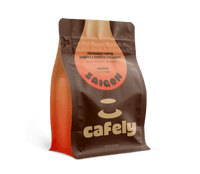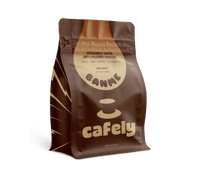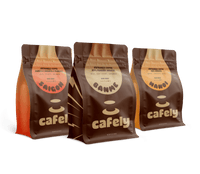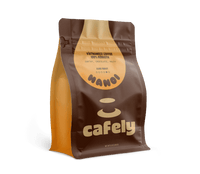The story of coffee’s origins begins in Ethiopia.
Legend has it that the beans were discovered by a goat herder named Kaldi. When taking his flock out to graze on the vast plateaus, he noticed that a particular plant drew more attention from his goats than the others.
The goats couldn't get enough of this plant and its berries. Whenever they ate it they would have such a surge in energy it would be difficult to get them to settle down for the night.
Intrigued, Kaldi decided to take his findings to the local monastery to see what the learned men there made of the curious effect of this plant on his goats.
The local abbot listened to the goat herder and decided the best way to see if these strange effects were true would be to try some himself. He made a drink out of the coffee cherries and noticed the same surge in energy as the goats. Instead of feeling a slump of energy during the long evening prayers, he was alert and awake.
He shared the drink with his fellow monks, and it quickly became a hit, spreading to other monastic communities.
Thus, coffee was born.
Related: 105 Coffee Facts (History, Health, & Trivia)
Coffee's Journey to Yemen
Word of this amazing plant soon spread, and coffee earned significant popularity in the Arabian Peninsula through historic trade routes between Ethiopia and the region. Coffee truly started to take off in Yemen, and the Yemeni people have their own origin story for coffee, which is not dissimilar to the one in Ethiopia. However, in this tale, Kaldi is a Yemeni Sufi mystic instead, and he noticed the energetic behavior in birds on his travels rather than goats.
However, we can't discount the real influence that Yemeni traders had in bringing wider popularity to coffee, as by the 16th century, it was being grown and consumed in Persia, Egypt, Syria, and Turkiye.
Coffee culture truly took form at the end of the 15th century, when it was no longer just an energy booster for monks. The first documented coffee house opened in Constantinople in 1475, and many more soon followed.
Coffee Houses & Social Exchange

Coffeeshops in 15th century Ottaman Empire were known as qahveh khaneh. Patrons visited not only to drink coffee, but to listen to music, watch performances, and exchange information and news with one another. Coffee houses were even affectionately known as “schools of the wise” for this reason.
Coffee houses were not the only way that the drink spread through the region. With the faithful and other curious pilgrims traveling to Mecca in their thousands year after year, word soon began to spread even further afield about the “wine of Araby.”
Coffee Spreads Across Europe
From the Middle East, coffee then started to make its way into Europe in the 17th century.
However, in some cases, it didn't exactly get the warmest of receptions. Some viewed this mysterious brown liquid as suspicious and potentially the work of Satan. However, when Pope Clement VIII, who was visiting Venice in 1615, was asked to give his official response to coffee, he asked to try it before making up his mind. He enjoyed his cuppa so much that coffee got papal approval!
Coffee soon spread across the continent, with every notable city sporting at least one coffee house. Coffee was particularly loved in Jacobean London. By the middle of the 1600s, there were over 300 coffee houses in the city. They were centers of knowledge and conversation, and more importantly, business.
Entrepreneurial Spirit
Many companies were founded in coffee houses, including the birth of modern insurance. One famous example is Edward Lloyd’s Coffee House, which went on to become the foundation for the insurance giant Lloyds, which is still around today.
Benjamin Franklin
One major fan of the London coffee houses was Benjamin Franklin, who frequented many of them during his 18-month stay in the city in 1724. Not only were they a great place to gather information and network, but Franklin also enjoyed coffee immensely.
To quote Franklin himself:
“Among the numerous luxuries of the table … coffee may be considered as one of the most valuable. It excites cheerfulness without intoxication, and the pleasing flow of spirits which it occasions… is never followed by sadness, languor or debility.”
Colonization of Warmer Climates
Of course, at this time, European countries were starting to cast their influence across other parts of the world with the spread of colonialization. A lot of the territories that were invaded and controlled in this way were warmer climates, which ironically, is perfect for growing coffee plants.
This is the reason why we have Vietnamese coffee today as it was introduced by French colonizers to the country. Although it has its origins in oppression and subjugation, it was reclaimed by the Vietnamese in their own right and is now an integral part of the culture.
Coffee in the New World
Colonists and traders also brought coffee to the New World. Plantations began to spring up in Central and South America, and countries such as Brazil and Colombia are where a lot of the world’s coffee comes from even today.
Unfortunately though, the rapid growth of coffee in the New World has its links to the slave trade. Alongside cotton and tobacco, coffee was seen as a valuable cash crop to grow with the help of slave labor.
Coffee and the slave trade were so intrinsically linked in Brazil that it was one of the reasons why the country was the last one in the Western Hemisphere to abolish it in 1888.
When it comes to the United States, coffee was part of the country’s fight for independence. It was in the Green Dragon Tavern and Coffeehouse in Boston where the Sons of Liberty hatched their plot to carry out the Boston Tea Party, and ever since then, coffee has been the drink of choice among most US citizens, partly to avoid association with the primarily tea-drinking British.
Related: Comparing Coffee vs. Tea
Modern Coffee Culture
Coffee culture has undergone a remarkable transformation in the modern era. Although our love of coffee houses has not faded, our relationship with the coffee we drink has changed dramatically.
Instead of just relying on coffee for energy like the Sufi monks in Yemen and Ethiopia, coffee is now tailored more toward the overall ritual. Because of this, you'll now see a greater emphasis on bean quality and origin, roasting methods, and even brewing techniques.
The Third Wave Coffee Movement

The so-called third-wave coffee movement has its origins in the late 1990s but has seen a massive shift in prevalence and popularity over the last decade or so. Rather than focusing on mass-market beans, single-origin coffee is the go-to. Baristas extract every last bit of potential from the beans using precision-based brewing techniques like pour-over and sophisticated espresso machines that can be calibrated to each unique blend.
Single-Origin & Specialty Coffees
Consumers are also more aware of where their coffee comes from and how it is farmed.
The coffee industry now widely embraces practices like fair trade agreements with roasters and coffee farmers. Interest in specialty coffees, single-origin coffee beans, and organic farming practices are now preferred around the world.
The environment is a major factor when it comes to coffee-buying decisions. Consumers are more likely to hunt out blends that have been produced using sustainable farming practices and roasting methods.
FAQs: Coffee Origins
If you still have questions about where coffee comes from, we’ve probably covered it below.
1. What is the most accepted legend about the origin of coffee?
The story of Kaldi, the Ethiopian goat herder, is the most popular legend about coffee's origin. This also goes hand in hand with the fact that coffee beans themselves can trace their roots back to the country.
Related: Weasel Coffee: Things You Should Know
2. How did coffee reach Yemen from Ethiopia?
Coffee beans made their way from Ethiopia to Yemen on the ancient trading route known as the Incense Route, which spread from the Meditteranean, North East Africa, Arabia, and beyond. It was when the beans reached Yemen that they began to be cultivated on a large scale. Today, coffee has become one of the most widely consumed drinks in the world, with Finland, Sweden, and Luxembourg consuming the most.
3. When did coffee houses first appear in Europe?
The first coffee house in Europe is said to have opened in Venice in 1645; however, there are accounts of earlier coffee houses, such as one established by Ottoman troops in 1529 in Vienna and one in Livorno in 1632. As record keeping is scarce, it can be hard to say for certain.
4. What role did coffee play in the American colonies?
Coffee became a patriotic alternative to tea after the Boston Tea Party as the country sought to distance itself from British rule. Coffee was also a significant part of the slave trade, and was a popular cash crop like tobacco or cotton.
5. How has coffee culture changed in recent times?
There has been a significant rise in specialty coffee and ethical consumption practices. Known as “third-wave coffee,” the focus is more on the coffee-drinking experience, almost elevating it to the same level as fine wines in some instances.
6. What is the significance of coffee in Middle Eastern culture?
Coffee has deep social and cultural significance, often associated with hospitality and community. For example, in Turkey, coffee is deeply embedded in the culture as a social practice, and they even have the saying that a cup of coffee can create memories that last for 40 years.
7. How did coffee cultivation spread to Latin America?
Coffee cultivation spread to Latin America through colonial expansion. It was primarily introduced into the Caribbean by the French in Martinique, and is where most of the coffee plants grown across the region have their origins.
8. What were the initial reactions to coffee in Europe?
Initial reactions were mixed, with some viewing it as a novel beverage and others as controversial. Some coffee skeptics even referred to it as the “bitter invention of Satan!”
9. How did coffee influence social life in the 17th century?
Coffee houses became centers of social, political, and intellectual exchange. Many companies have their founding origins in coffee houses, which were also colloquially called “penny universities” due to the amount of knowledge and debate being shared.
10. What are the main types of coffee beans used today?
Arabica and robusta are the two main types of coffee beans used globally, though the lighter-tasting Arabica variety is more popular due to its delicate and brighter flavors. Robusta is becoming more popular thanks to the rise of Vietnamese coffee.
Vietnam is the second-largest exporter of coffee, and most of it is robusta, although the country also produces other coffee types. If you want to truly understand why Vietnamese coffee is in high demand, try authentic Vietnamese iced coffee made with the phin filter. You will forever be a fan.
Related: The Differences Between Arabica & Robusta Explained












